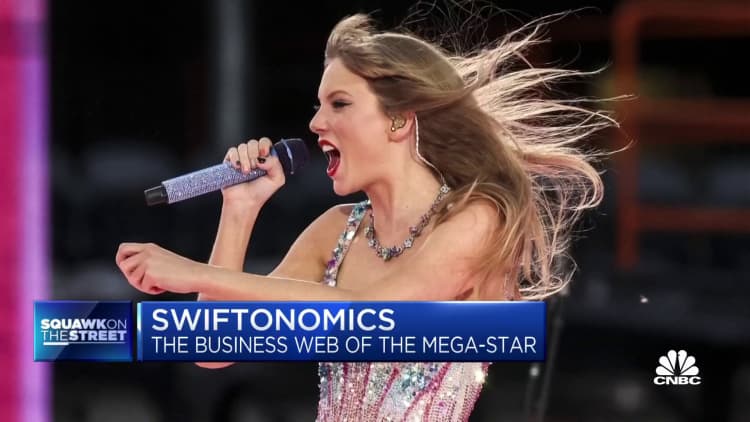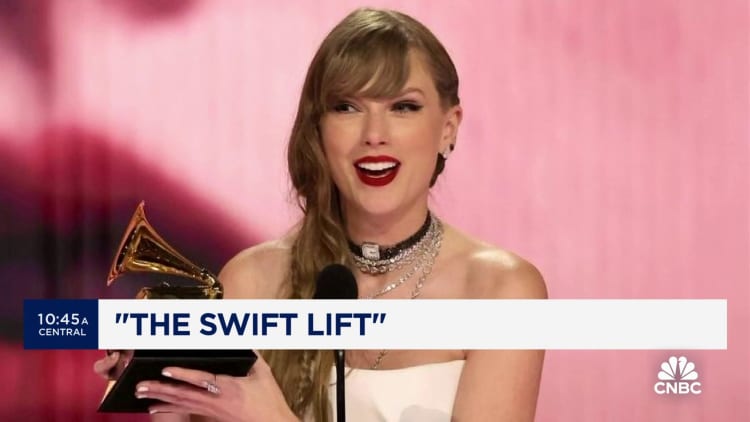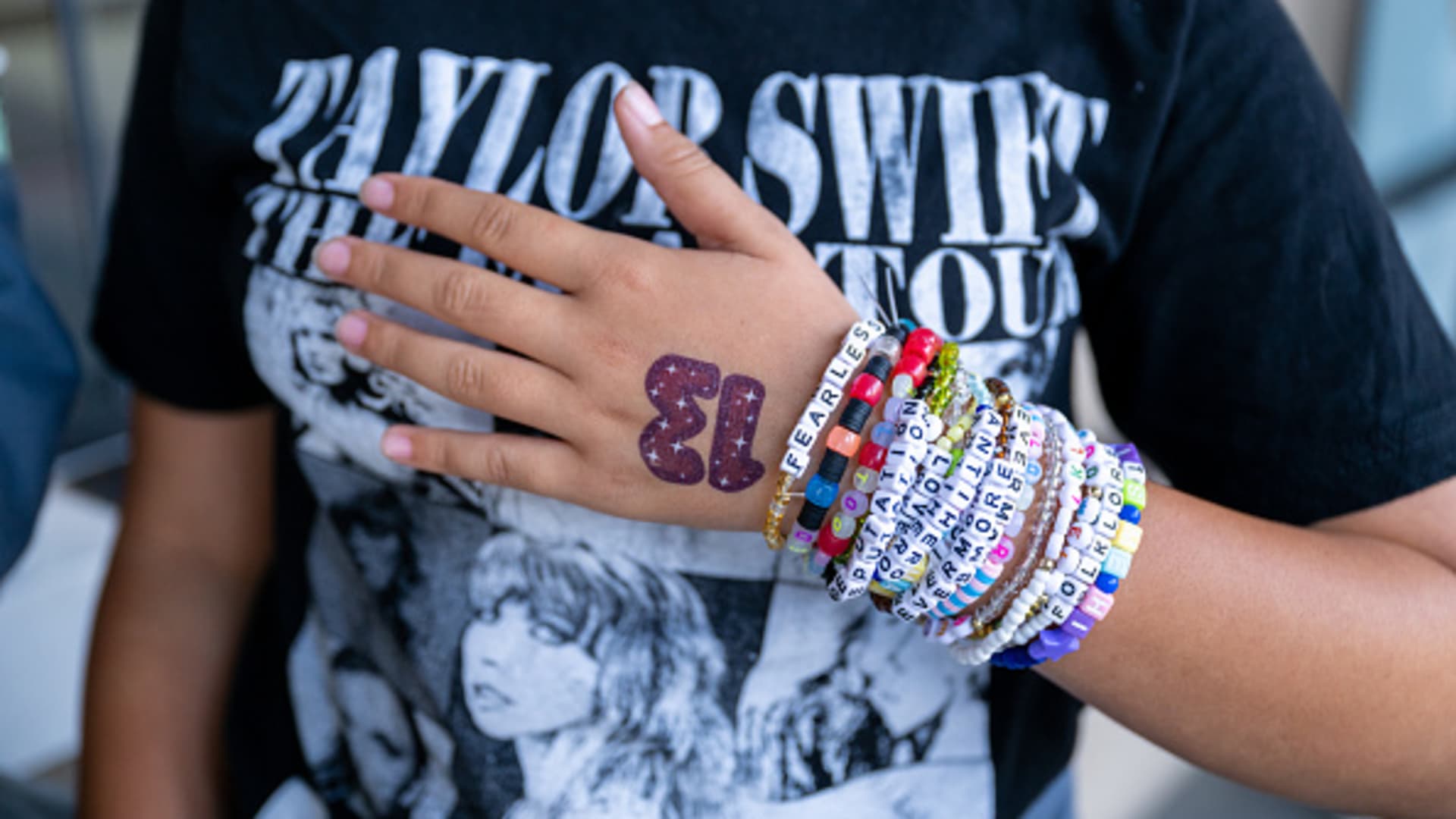Amanda Edwards | Getty Images Entertainment | Getty Images
In Middletown, Ohio, a line of fans snaked around the Skateway’s parking lot on Presidents Day. Traffic backed up on the main street out front. A pizza truck lumbered into the already crowded lot to deliver some pies. A crowd of predominantly young girls showed off Taylor Swift-themed bracelets and sang “Shake It Off.”
The atmosphere had all the trappings of an Eras Tour stop. Except the singer was nowhere in sight.
But that didn’t matter to the crowds of people who attended. And it didn’t matter to the rink owners. Over 300 skaters and some parents took the small rink close to capacity during the two-and-a-half hour “Swiftie Skate.”
The event was so popular that the rink owners are planning a repeat soon.
“We know Taylor Swift is popular; her music is the most requested at the rink,” said Ginny Kidd, Skateway spokesperson. Kidd said the skate session was augmented with Swift-themed friendship bracelets, t-shirts, themed drinks, and the top Swifty fan crowning.
“It was one of our most successful events,” Kidd said.
Gonzaga University economics professor Ryan Herzog says that while quantifiable economic data is challenging, it makes perfect sense for small businesses like Skateway to try to get a cut of the Taylor action.
“Nothing is preventing a rink from playing Taylor Swift music and getting a line out the door. Those numbers won’t show up in economic data but will show up in the bottom line of small businesses,” Herzog said.
Herzog and New York Times Op-ed columnist and Nobel Prize-winning economist Paul Krugman developed a class of economic principles tied to Taylor Swift’s success.
“She is in and of herself an economic event. She is a global economic phenomenon, even at the micro level,” Herzog said of the singer, who earlier this week was named to the inaugural CNBC Changemakers list, which spotlights women bringing innovation to the business world and global economy.

The Taylor Swift events that don’t involve Taylor Swift showing up range from library events, to bar crawls, cruises, painting parties, dance parties, and more.
At Lumi by Akira Back, an upscale Japanese food restaurant in San Diego’s trendy Gaslamp Quarter, restaurant management decided to host a Taylor Swift Brunch on the same August weekend the singer was scheduled in Los Angeles.
“Within a few hours, we had sold out the day,” said Katie Bosworth, director of marketing for RMD Group, which owns Lumi.
The rethemed menu featured $13 mimosas in homage to the star’s favorite number, cocktails named after Swift’s cats, and a bracelet swap as the singer’s remixed music played. The restaurant added another Swift brunch the following weekend and plans a listening party when the singer’s new album is released in April.
The brunch attracted 140 people for each and a waiting list. Bosworth says the response to Swift is comparable to the boost the restaurant gets during San Diego’s Comic-Con convention, which draws over 100,000 to the city, and that the economic ripple effect was evident in the brunch-goers that then went shopping at the artisan market in the adjacent Gaslamp District.
“It’s a great way to cross-pollinate business,” Bosworth said, adding that the restaurant used the experience to engage with potential new customers. They expected the brunch to attract regulars, but it brought mainly Swift fans who had never been to the restaurant.
The Swift microeconomy reaches all corners of the country, and cuts across age groups.
Katie Lovell, private events manager for the Palace and Rex Theatres in Manchester, New Hampshire, wanted to hold a dance party to bring some younger customers to the local landmark. She thought that a Taylor Swift event would be successful.
The theater held two Swift dance parties on December 30, and they both swiftly sold out. Tickets were $20 for children under $12 and $25 for older. Lovell, herself a Swiftie, put together a playlist and video content, created signature drinks, a bracelet station, a face glitter station, a photo booth, Swift cardboard cuts, and more for the attendees.
“It was a really fun event, very positive,” Lovell said. She could see the economic ripple effect that the 600 attendees created outside the theater.
“People went out to eat and shopping downtown,” Lovell said, adding that for a lot of people that came, it was the first time to the Rex Theater and downtown Manchester. The event was such a success they’ll be holding another one on March 23.

With so many Taylor Swift items and terms trademarked by the singer (Swifties, for instance), some marketers are careful to tiptoe around violations.
Rebecca Landry, a Swiftie mom and travel agent in Frisco, Texas, responded to her 18-year-old daughter’s wish for a Taylor Swift cruise by organizing one herself. Landry put together a Taylor Swift-themed cruise that complete with a midnight pajama party, Taylor trivia, bingo, and karaoke, on Royal Caribbean, leaving Galveston in June. She wanted an event catering to small-town Swifties in the Plains that couldn’t make it to Miami, where some larger lines have Swift-themed cruises. Landry is christening it the Summer Era Cruise but is careful to point out that the event is not affiliated with the singer.
Why the Swift microeconomy is good for Taylor, too
Brittany Hodak, celebrity branding expert and author of “Superfan,” says these small venues probably don’t have to worry about hearing from Swift’s attorneys.
“Her team is savvy enough to know anytime she sends any letter, there will be coverage. So their strategy in protecting themselves is not so teenage fans in Montana can’t throw a skating rink party but to keep larger organizations and business models from making millions by creating confusion in the marketplace, by having fans think there is an affiliation or support from Taylor for things that don’t exist,” Hodak said.
And for Swift, these small-town celebrations’ economic impact and branding benefits are significant.
“One of the most powerful things that she has done is create a community that her fans want to be a part of in any way they can. Since she is only one person, she can only be in one city at one time. For superfans who can’t be where she is that night, there is still a desire to come together communally to celebrate and take joy,” Hodak said. That joy has created its own “Swift micro-economy” that may fly under the Federal Reserve’s radar — its Beige Book on national economic performance recently included an accounting of the Eras tour impact on Philadelphia — but not the radar of the local craft shop or dance studio.
“She has been able to create an entire economy around people who love and support her,” said Hodak, who worked with Swift on some projects early in her career.
Small businesses will continue to capitalize with the new Swift album due out in April and the singer’s popularity sky-high.
Herzog, however, thinks that the Swift economic phenomenon will fade over time.
He may not be a hater, but he said, “I think we are at peak.”

